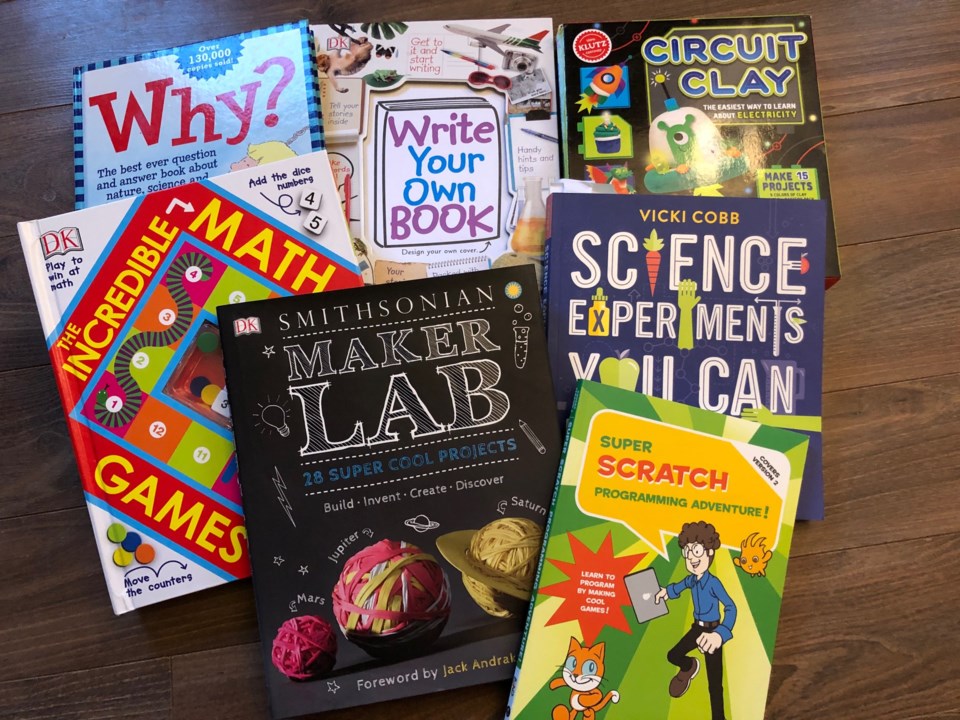The kids are out of school and you still want them to learn, but there is also a reason why you didn't become a teacher.
Well, parents, you are in luck. There are lots of books out there that are fun and will teach your kids a thing or two.
Here are seven books that make learning fun.
Circuit Clay, the easiest way to learn about Electricity (Klutz Books, http://www.scholastic.ca/
Like all Klutz books, this package comes with everything you need to make 15 projects from a basic circuit to a flashlight that works. The kit comes with a battery pack, paper pieces, four colours of conductive clay, white insulating clay and 20 LEDs and a booklet that offers step-by-step instructions (and pictures) on how to make a dragon with flashing eyes or a police car with flashing lights.
The Incredible Math Games Book (DK Books, https://www.dk.com/ca/ )
Math is not my favourite thing in the world and in fact I often ask What's the Point of Math? (which another DK book answers. FYI, apparently quite a lot). However, for people who do like math, or those who like games, this book uses dice, counters and flaps to help kids practise adding and subtracting, fractions, shapes and more. Each game offers clear instructions, tells parents what skills it practises and offers lots of places to flip and reveal.
Smithsonian Maker Lab (DK Books, https://www.dk.com/ca/ )
STEM (science, technology, engineering and math) projects are quite popular these days and there 28 projects to create in this book from soap-powered boats to a jungle and a lemon battery. Each project gives you information about the project and what you hope to do achieve by doing it. Some projects offer step-by-step instructions with pictures, while others just show you the completed project. All projects offer lots of information in small chunks.
Super Scratch Programming Adventure (No Starch Press, https://nostarch.com)
Scratch is a free software, available online, which teaches kids how to code. It's super easy to use and really fun. Kids can create their own projects, which can stay private, or they can put them online for others to see. We have a lot of Scratch books, including several by DK Books, but this is my favourite starting book as it walks you through the basics of the program. The book is part graphic novel and part instruction manual. You read the graphic novel and then do a project, which relates to the story. The other Scratch books are great as well and we have used them a fair bit, but I recommend starting with this one.
Science Experiments You Can Eat (Harper, www.harpercollinschildrens.com
As the title suggests, these science experiments all involve food – making and eating it. Each experiment offers information about the science behind it, then goes into the materials and equipment, the procedure and observations. There is also a section for kids to write notes. Experiments include Grape Jelly (How Pectin Acts); Sally Lunn Bread (A Study of Yeast Activity); and Baked Steak (Acids, Bases, and Enzyme Actions). My complaint about the book is that there is a lot of information and no pictures.
Why? (OwlKids, https://www.owlkids.com/ )
Why? answers dozens of questions kids have about everything from nighttime questions to kitchen questions and bathtime questions. Each question is simply asked and answered in a way that is easy to understand and short. That white line in the sky? A trail of ice where jet planes have been. Why can't I see just after the lights go out? Because your eyes haven't adjusted yet and your pupils – the middle of your eye - is still small. OwlKids also has a book called How? answering questions about how things work.
Write Your Own Book (DK Books, https://www.dk.com/ca/ )
Write Your Own books gives kids prompts and ideas on writing everything from fairy tales to comic strips. The book is super colourful and offers space – but not too much space – for kids to write their own stories. The book also tells readers the parts of the story with tips on how to develop them, writing challenges and ides from pirate stories to aliens.
So here are just seven books that will help your kids have fun while learning. There are certainly more, check out Book Time to read reviews about all kinds of books. Happy reading.
Lisa Day is the author of two book blogs – Book Time (https://booktime584.
See me on LinkedIn at bit.ly/lisamdayc , follow me on Twitter @LisaMDayC , Instagram @LisaMDayC and @LisaMDayReads , and check out Book Time at https://booktime584.
